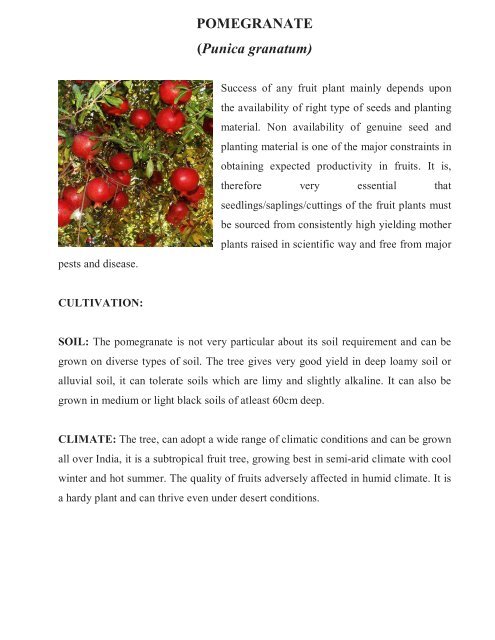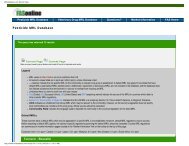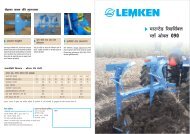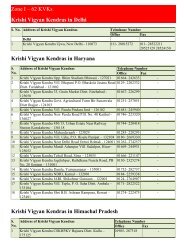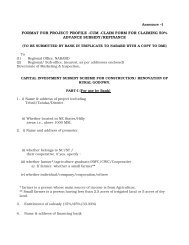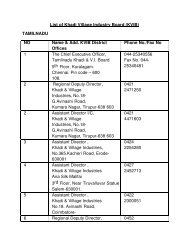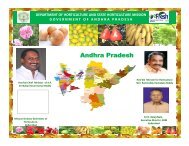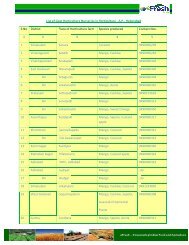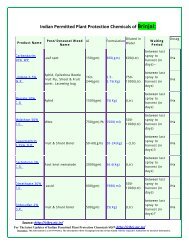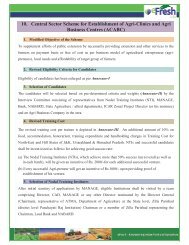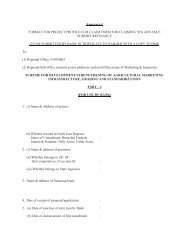POMEGRANATE (Punica granatum) - Efresh India
POMEGRANATE (Punica granatum) - Efresh India
POMEGRANATE (Punica granatum) - Efresh India
Create successful ePaper yourself
Turn your PDF publications into a flip-book with our unique Google optimized e-Paper software.
<strong>POMEGRANATE</strong><br />
(<strong>Punica</strong> <strong>granatum</strong>)<br />
pests and disease.<br />
Success of any fruit plant mainly depends upon<br />
the availability of right type of seeds and planting<br />
material. Non availability of genuine seed and<br />
planting material is one of the major constraints in<br />
obtaining expected productivity in fruits. It is,<br />
therefore very essential that<br />
seedlings/saplings/cuttings of the fruit plants must<br />
be sourced from consistently high yielding mother<br />
plants raised in scientific way and free from major<br />
CULTIVATION:<br />
SOIL: The pomegranate is not very particular about its soil requirement and can be<br />
grown on diverse types of soil. The tree gives very good yield in deep loamy soil or<br />
alluvial soil, it can tolerate soils which are limy and slightly alkaline. It can also be<br />
grown in medium or light black soils of atleast 60cm deep.<br />
CLIMATE: The tree, can adopt a wide range of climatic conditions and can be grown<br />
all over <strong>India</strong>, it is a subtropical fruit tree, growing best in semi-arid climate with cool<br />
winter and hot summer. The quality of fruits adversely affected in humid climate. It is<br />
a hardy plant and can thrive even under desert conditions.
POLLINATION: Pomegranate is self pollinated as well as cross pollinated crop.<br />
However, hand pollination and pollination under natural conditions give rise to greater<br />
percentage of fruit set.<br />
VARIETIES: Popular <strong>India</strong>n varieties of pomegranate are Ganesh, Arakta, Mrudula,<br />
Bhagwa,and Muskati Red .<br />
CULTIVATION PRACTICES IN BRIF:<br />
Land preparation: 2-3 deep ploughings, followed by leveling of land .Spacing 5m<br />
x5m, according to square or hexagonal system. The pits of 60cmX60cm X60cm are<br />
dug for planting of seedlings.<br />
Propagation: Pomegranate plant is a rounded shrub or small tree that can reach 20 to<br />
30 feet in height. It is propagated by raising seedlings, but the seedlings vary too<br />
much. The low yields, poor fruit quality is mainly due to seed propagation. Vegetative<br />
propagation is more dependable for multiplication. Therefore, common method for<br />
propagation is by rooting hard wood cuttings. The cuttings are taken from fully mature<br />
wood, about one- year- old. The cuttings are usually taken from suckers which spring<br />
from the base of main stem and should be 25-30cm long. If cutting are treated with<br />
200ppm IAA(Iodole Acetic Acid), profuse root system is developed. The rooting is<br />
more effective in rainy season. They are planted in beds during monsoon season at<br />
distance of about 40 to 60cm apart. A year after, rooted cuttings are lifted out with a<br />
ball of earth around their roots and transplanted in the orchard. The pomegranate<br />
may also be propagated by air layering or gootee.<br />
PLANTING: The normal spacing of planting is 5m X 5m, however, the spacing of 5<br />
X 2m gave highest yield as compared to the normal spacing 5 X 5m without affecting<br />
the fruit quality. In each pit, 20-25kg FYM or compost, 1kg SSP mixed with soil is
filled upto land level. In the rainy season, the grafts/seedlings of desired variety are<br />
planted. For normal spacing 400 grafts are required for one hectare area.<br />
TRAINING: Allow pomegranate plants to grow in bush form with a number of<br />
shoots arising at ground level. Young plants are properly trained to form a single stem<br />
with a number of well distributed scaffold limbs. All the side shoots should be<br />
removed at a time of planting.<br />
PRUNING: Pomegranate does not usually require pruning except for removing the<br />
suckers and giving a shape to the tree.<br />
IRRIGATION: Pomegranate responds well to irrigation. In bed or basin system,<br />
small round basins are made at the base of each tree and filled with water. Regular<br />
irrigation is essential during fruiting season, as irregular moisture conditions results in<br />
cracking of fruits.<br />
MAURING AND FERTILIZERS: Well rotten FYM is applied to pomegranate<br />
plants at the rate of about 20kg per tree while planting. After this, about 20kg of FYM<br />
is given to each plant every year at the break of Monsoon. Application of small<br />
quantity of ammonium sulphate is also recommended.<br />
Bearing orchards should be given 500gm N, 250gm P 2 O 5 and 250gm K2O/per<br />
plant,as it has been found adequate for 4-6 years old bearing trees for economic yield.<br />
INTERCROPPING: Low growing vegetables, pulses or green manure crop are<br />
suggested to be grown as intercrop in between old trees till 4 to5 years of crop age.<br />
PROPAGATION TECHNIQUES OF <strong>POMEGRANATE</strong>:<br />
1. Seed: Propagation from seed is a very easy method. Seed propagation is also<br />
economical than other methods of propagation. But the seedlings are not true to
type and can loose some of the good qualities of established cultivars. Therefore<br />
,the seed propagation is not used in large scale production. It also takes longer<br />
for a fruit producing plant to grow from seed than other methods.<br />
2. Hardwood Cuttings: Hardwood cutting is most commonly used method for<br />
propagation of pomegranate. The cuttings are taken from fully mature, about<br />
one year old wood. The cuttings are taken from the base of the main stem and<br />
should be 25-30cm long. Treat the cuttings with 200ppm IAA for profuse<br />
root system. Cuttings should be planted during monsoon at a distance of about<br />
40-60cm apart. A year after, rooted cuttings are lifted out with a ball of earth<br />
around their roots and transplanted in the orchard.<br />
3. Air-layering (gootee): The pomegranate may also be propagated by airlayering.<br />
After removal of foliage, branches of pencil size should be selected.<br />
Bark of 1cm diameter should be removed from the selected branch. Care should<br />
be taken to remove the upper layer (phloem). The xylem should not be<br />
damaged. Treat the cut portion with IBA at 10,000 ppm in lanolin as carrier for<br />
including profuse rooting. Cover the cut portion with mass grass and wrap with<br />
white polythene. After two to two and half months, the root growth is<br />
completed. Cut the rooted cuttings from the main tree and re-plant in poly bags<br />
having mixture of soil and organic manure.<br />
Bahar or Resting Treatment: To regulate fruiting, water is withhold for about<br />
2 months in advance of normal flowering season. To obtain higher fruit yield<br />
during a particular period, plants are given a resting period by which the natural<br />
tendency of the tree is altered with artificial means. Flowering can be induced<br />
in June.<br />
Bahar Period Fruit Maturity<br />
Ambe Bahar January-February June-August<br />
Mrig Bahar June-July November-January
Hasth Bahar September- October February-April<br />
Important Diseases, Pests and Disorders:<br />
1. Diseases:<br />
(i) Leaf Spot: (Xanthomonas punicae, Colletotrichum gloeosporioides) :<br />
The disease is caused by both bacteria and fungus. The irregular water soaked light<br />
brown to dark brown spots on leaves are caused by bacterium, while minute violet<br />
black or black spots on leaves are caused by fungus. For control of the disease<br />
spray 0.2% captan or dithane M-45 at fortnightly intervals. Proper sanitation of the<br />
orchard should be maintained .<br />
(ii) Fruit Rot (Phomopsis sp): This disease occur on flowers and they fail to set<br />
fruit. The young fruits may drop pre-maturely. Yellow or black spots appear all<br />
over the fruit. The disease spreads through the seeds of affected fruits. Rainy<br />
season, favours the spread of disease.<br />
Remove all affected twigs, fruits and burn them. Spray Dithane Z-78 at 0.2% at<br />
fortnightly intervals.<br />
(iii) Wilt (Fusarium, Rhizoctonia, Nematodes): Wilt in pomegranate is caused<br />
due to fungi and nematode. Plants, initially look yellowish followed by flower,<br />
fruit drop and drying of branches and stem. In severe cases entire orchard is<br />
wilted. The causal organisms are since soil-borne, it is essential to maintain well<br />
drained soil, judicious irrigation and application of FYM , Neem cake, copper<br />
oxychloride drenching @0.3% and soil treatment with trichoderma @10-15kg/ha.<br />
2. Insect pests:<br />
(i) Fruit borer or pomegranate butter fly (Virochola isocrates): Infestation<br />
starts from flowering to button stage. Catter-pillars bore inside the developing
fruits and feed on pulp and seeds. Damaged fruits are subsequently infected by<br />
bacteria and fungi which causes fruit rot.<br />
Collect and destroy the affected fruits. Apply Carbaryl 0.2% @4g/liter or<br />
phosphamidon @ 0.3ml/liter water at 10-15 days intervals.<br />
(ii)Bark eating catter pillar (Inderbela tetraonis): This pest bore into the bark of<br />
pomegranate tree and feed inside. Trees become weak and fail to bear fruits.<br />
Maintain sanitation, remove unwanted twigs, clean the affected portions by<br />
removing all webs. Injecet Kerosene oil or petrol and plug the hole with cotton<br />
wool soaked in carbon disulphide.<br />
(iii) Stem borer(Aleurodes sp): Caterpillar makes a hole and bores through the<br />
main trunk or branches, In night, insect feeds on bark.<br />
Clean the hole by removing insect excreeta. Plug the hole with cotton, dipped in<br />
petrol, chloroform, carbon di sulphide or kerosene oil and seal it by mud paint with<br />
coltar.<br />
(iv) Sap sucking insects: Mealy bugs (Drosicha mangiferae), scale insects<br />
(Saissetia nigra), thrips, aphids (Aphis punicae), mites (Tenuipalpus punicae) all<br />
these insects suck the cell sap from leaves, fruit and twigs. Resulting in shedding<br />
of buds, flowers and fruits.<br />
Spray 0.04% for monocrotophos for the control of mealybuges and scale insects.<br />
Dimethoate or phosphomidon@0.04% for control of white flies, aphids and thrips<br />
for red mites wettable sulphur @1.25g/liter.<br />
HARVESTING AND YIELD:<br />
The fruits are ready for harvest after 5-7 months after blossom. When skin turns<br />
slightly yellow, fruits gives a metallic sound when tapped, the fruits are harvested.
Each tree bears about 100 fruits and continues to give economical crop upto 25-30<br />
years.<br />
PACKING: After harvesting, the fruits are graded according to the size. The<br />
sound and healthy fruits are packed mostly in bamboo baskets and wooden crates<br />
containing 10-12kg fruits with a padding of paddy straw or dry grasses. They<br />
transported to distant markets without any transportation loss.<br />
STORAGE: Pomegranate keeps well for a longer time. Fruits stored at 0 degreeC<br />
and 4.5 degree C at 80-85% RH did not undergo any shrinkage or spoilage for<br />
seven months.<br />
Dos and Don’ts:<br />
Dos:<br />
1. Always purchase the seedlings from genuine sources and certified nursery.<br />
2. Select well drained, deep loamy soil for pomegranate plantation for high yield.<br />
3. Practice hand pollination in pomegranate for good yield.<br />
4. Plant the seedlings at 5x2 m distance or at 5x5m distance, depending upon the<br />
growth of plants and climate.<br />
5. Irrigation should be regular and protection chemicals must be applied at<br />
required time and in the recommended dose.<br />
Don’ts:<br />
1. Seedlings should never be purchased from ungenuine source, without<br />
knowledge of the required variety and its varietal characters.<br />
2. Never cultivate pomegranate in high humid areas,<br />
3. Infrequent and irregular irrigation should not be given, otherwise fruit cracking<br />
will occur.<br />
4. Never grow intercrops in pomegranate orchad after 5 years.<br />
5. Avoid dense plantations.<br />
Certification in Pomegranate:
By and large, pomegranate is a vegetatively propagated crop. Thus Seed<br />
Certification Act is not enforced in this crop. The Nursery Act 1969 is applicable<br />
to pomegranate. The important points of Maharashtra Fruit Nursery Act,<br />
1969, 1976 and Maharashtra Fruit Nursery (Rules) Act, 1978(revised) are<br />
given here under:<br />
1. Fruit Nursery owner should obtain license for each fruit crop.<br />
2. The nursery owner should apply in writing to the Competent Authority for<br />
obtaining license by paying prescribed fee as a fruit nursery grower, with<br />
following terms and conditions:<br />
(i) Applicant should be capable of raising nursery.<br />
(ii) Applicant should be competent to grow fruit nursery.<br />
(iii) Applicant has paid prescribed fee.<br />
(iv) Nursery grower should produce quality planting material, sell it at a<br />
reasonable rate. This term should agreed upon and guaranteed by the<br />
nursery owner.<br />
3. Responsibility of Nursery Grower :<br />
(i) The scion and root stocks should only be used as directed by<br />
Competent Authority.<br />
(ii) He shall maintain records of traceability of scion and root stocks.<br />
(iii) He shall have knowledge of growing particular fruit nursery with the<br />
local and botanical name.<br />
(iv) He shall maintain mother plant and keep the nursery free from insects<br />
and diseases.<br />
(v) He shall agree to follow the instructions of the Competent Authority<br />
for growing fruit nursery.<br />
(vi) Ha shall maintain the name of varieties, age of crop and name of<br />
scions on tags attached with plants.<br />
(vii) He shall sell only healthy nursery.
(viii) He shall maintain a sale register mentioning the name of nursery,<br />
crop, variety, age, mother plant and the name of the person who has<br />
purchased the seedlings. The details should be submitted to the<br />
Competent Authorities on demand.<br />
4. Transportation of diseased and insect attacked seedlings from one place to other<br />
is prohibited under the Act. This will prevent the transmission of the disease<br />
and insect pests to other states.<br />
5. If the nursery owner is failed to comply with the terms and conditions, the<br />
license of the such nursery owner is liable to be cancelled.<br />
6. Renewal of the nursery licence can be done by paying required fee.<br />
Format ‘A’<br />
[See Section 3 (1)]<br />
Application Format for License under Section 3 of<br />
Maharashtra Fruit Nursery (Rules) Act, 1969,<br />
1. Name of the Nursery:----------------------<br />
2. Name and address of the Owner:----------------<br />
3. Place of Nursery:<br />
(i) District:---------<br />
(ii) City/Village:--------<br />
(iii) Nearest railway station:------------<br />
4. Total area of nursery along with mother plants with survey no:----------<br />
A. Details of Mother Plants----<br />
(i) Survey no and Area:--------------<br />
(ii) Name of variety and kind of fruit plants:------------<br />
(iii) Total number of plants;----------<br />
(iv) Age of fruit plant, source of mother plant;----------<br />
If no, information about the source of mother plant,
in that condition, before use of these plants as<br />
mother plant it is essential to see quality and<br />
fruits of such mother plant: ---------------------------<br />
B. Details of mother plant of the root stock<br />
(i) Survey no and Area:------------<br />
(ii) Type of root stock and variety:------------<br />
(iii) No of plants:---------------<br />
(iv) Age of plants:------------------<br />
(v) Source of mother plant:----------------<br />
Provide details about original root stock plant,<br />
If not from same nursery: ---------------------------<br />
C. Provide details of variety wise and total number of he grafted, budded or rooted<br />
plants for the every year but it depends upon the need of applicants:<br />
Name of Fruit Plant Variety Production<br />
technology<br />
No of plants to be<br />
produced<br />
5. From which period applicant doing this nursery business? If so, give the data<br />
for variety wise plant produced and sale of last two years:<br />
6. Give the details of plant protection measures used for prevent the attack of<br />
insect, pests and diseases :<br />
7. Details of License fee:<br />
8. Affidavit :<br />
(I) I, hereby declare that all the above information given by me are true and<br />
correct to the best of my knowledge, information and belief.<br />
(II) I, hereby declare that for the purpose of any contravention or evasion of the<br />
provisions of the Act or any other rule, regulation, notification or order made
there under, if any changes are there by the time we will fulfill all the<br />
conditions<br />
(III) I assure for sale at reasonable price of quality plant.<br />
(IV) I assure that if there is non-availability of grafted and original plants in<br />
nursery then I will plant those in next coming season.<br />
Place:<br />
Date:<br />
Signature of Applicant<br />
Address:------------------<br />
------------------------------


